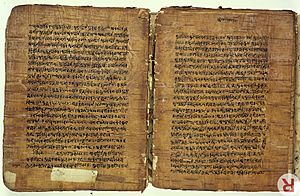Pāṇini facts for kids
Quick facts for kids
Pāṇini
|
|
|---|---|
|
Notable work
|
Aṣṭādhyāyī (Classical Sanskrit) |
| Era | fl. 4th century BCE; older research mentions "6th to 5th century BCE" |
| Region | Northwest Indian subcontinent |
|
Main interests
|
Grammar, Linguistics |
Pāṇini (पाणिनि) was a very important scholar from ancient India. He lived a long, long time ago, around the 4th century BCE. Some older studies suggest he lived even earlier, between the 6th and 5th centuries BCE.
Pāṇini was a philologist, which means he studied languages and their history. He was also a grammarian, someone who studies the rules of a language. Many people call him the "father of linguistics," which is the scientific study of language. He likely lived in the northwest part of the Indian subcontinent, in an area called Gandhara, which is now in modern Pakistan.
Contents
Pāṇini: The Ancient Language Master
Pāṇini is most famous for his book called Ashtadhyayi. This book is a detailed guide to the Sanskrit language. It contains nearly 4,000 rules about how Sanskrit words are formed and how sentences are put together. These rules cover things like syntax (sentence structure) and semantics (the meaning of words).
The Ashtadhyayi: A Book of Rules
The Ashtadhyayi is written in a special style called sutra. This means it uses short, clear rules or verses. It has "eight chapters," which is why it's called Ashtadhyayi (meaning "eight chapters"). This book became the main text for the Vyākaraṇa branch of the Vedanga. The Vedanga were important subjects studied in ancient India, like grammar, astronomy, and phonetics.
Pāṇini's book was so important that many other scholars wrote bhashya (commentaries) to explain his rules. The most famous commentary is the Mahābhāṣya by Patanjali. Pāṇini's ideas also influenced scholars in other Indian religions, like Buddhism.
Why Pāṇini Was So Important
Pāṇini's way of looking at language was very advanced. His ideas about how words combine to form new words (called noun compounds) are still used in modern language studies. His detailed and scientific approach to grammar helped make Sanskrit the most important language for learning and literature in India for over 2,000 years.
Pāṇini's ideas about how words change their form (called morphological analysis) were more advanced than any similar ideas in the Western world until the 1900s. His book was so precise that it has been compared to a Turing machine. This is a theoretical model that shows how any computer device can work.
What Pāṇini's Name Means
The name Pāṇini is a patronymic. This means it tells you about his father or ancestor. Pāṇini means "descendant of Paṇina." His full name was "Dakṣiputra Pāṇini." "Dakṣiputra" suggests that his mother's name was Dakṣi.
Images for kids
See also
 In Spanish: Panini (gramático) para niños
In Spanish: Panini (gramático) para niños



